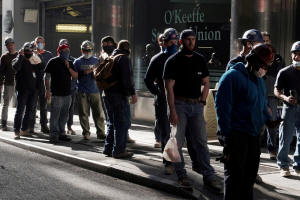U.S. labor market roars back; full recovery still years away
 Send a link to a friend
Send a link to a friend
 [March 06, 2021] By
Lucia Mutikani [March 06, 2021] By
Lucia Mutikani
WASHINGTON (Reuters) - The U.S. economy
created more jobs than expected in February as falling new COVID-19
infections and additional pandemic relief money from the government
boosted hiring at restaurants and other services businesses, firmly
putting the labor market recovery back on track.
Though job growth momentum is expected to build in the months ahead amid
an acceleration in the pace of vaccinations and more fiscal stimulus, it
will probably take several years for the labor market to heal from the
deep scars inflicted by the coronavirus pandemic, which is now in its
second year.
The Labor Department's closely watched employment report on Friday
showed at least 4.1 million Americans have been out of work for more
than six months, accounting for 41.5% of the unemployed population in
February. Another 3.5 million have permanently lost their jobs.

Graphic: Unemployment duration - https://graphics.reuters.com/USA-STOCKS/xegpbwrqdvq/ueduration.png
"There remains easy fuel for strong payroll gains in coming months as
the reopening gains momentum," said Robert Rosener, an economist at
Morgan Stanley in New York. "But there is much further to go before
conditions are consistent with maximum employment."
Nonfarm payrolls surged by 379,000 jobs last month after rising 166,000
in January. Payrolls fell in December for the first time in eight
months. The economy has recouped 12.7 million of the 22.2 million jobs
lost in the pandemic recession.
Economists polled by Reuters had forecast February payrolls increasing
by 182,000 jobs. Restaurants and bars hired 286,000 workers, accounting
for 75% of the payrolls gain. There were also increases in employment at
hotels and motels and at amusements, gambling and recreation
establishments.
Altogether, leisure and hospitality employment jumped by 355,000 jobs,
making up 94% of all jobs created last month.
Temporary help, a harbinger for future hiring, increased further.
Healthcare and social assistance also added jobs, and retailers hired
41,000 workers. Manufacturing payrolls increased by 21,000 jobs. About
half of the factory job gains were in transportation equipment, despite
a global semiconductor chip shortage, which has forced some automakers
to cut production.
But construction employment decreased by 61,000 jobs because of bitter
cold across the country. Government payrolls dropped by 86,000 jobs,
with losses concentrated at state and local governments. The diffusion
index, or measure of private industries expanding, jumped to 57.0 from
48.4 in January.
Unseasonably cold weather shortened the average workweek to 34.6 hours
from 34.9 hours.
The surge in hiring follows on the heels of a strong rebound in consumer
spending in January, which prompted economists to sharply upgrade their
growth estimates for the first quarter.
A decrease in daily coronavirus cases and hospitalizations, and nearly
$900 billion in stimulus provided by the government at the end of
December are driving the revival in activity.
That has raised concerns that President Joe Biden's $1.9 trillion
recovery plan under consideration by Congress, combined with the Federal
Reserve's near zero interest rates and bond purchases, could cause the
economy to overheat.
[to top of second column] |

Construction workers wait in line to do a temperature test to return
to the job site after lunch, amid the coronavirus disease (COVID-19)
outbreak, in the Manhattan borough of New York City, New York, U.S.,
November 10, 2020. REUTERS/Carlo Allegri

U.S. Treasury yields have spiked as investors anticipate higher inflation. Biden
is not backing down.
"Without a rescue plan, these gains are going to slow," Biden said at a White
House economic briefing. "We can't afford one step forward, two steps backward.
People need the help now."
Fed Chair Jerome Powell on Thursday again brushed aside the inflation concerns,
saying he expected the U.S. central bank "will be patient" until the economy is
"very far along the road to recovery."
Stocks on Wall Street rallied, while the dollar rose against a basket of
currencies. U.S. Treasury prices were higher.
Graphic: Nonfarm payrolls - https://graphics.reuters.com/USA-STOCKS/xklpyoabapg/nfpr.png
PLENTY OF SLACK
Even as the labor market recovery is regaining steam, ample slack remains.
Though the unemployment rate fell to 6.2% last month from 6.3% in January, it
continued to be understated by people misclassifying themselves as being
"employed but absent from work." Without this problem, the unemployment rate
would have been 6.7%. It is about 9.5%, including people who have given up the
search for work.
While the share of long-term unemployed is below its peak near 45% during the
Great Recession, it is far higher than in previous downturns where it rose not
much above 20%.
"This indicates that unemployment is highly concentrated among people who lost
their jobs near the start of the recession, rather than workers going through
relatively short spells of unemployment," said Dean Baker, economist at the
Center for Economic and Policy Research in Washington.

Unemployment remains high among Blacks and Hispanics, as well as Americans
without a high school diploma and college degrees.
The labor force participation rate, or the proportion of working-age Americans
who have a job or are looking for one, was steady at 61.4% in February. The
participation rate has tumbled from 63.3% in February 2020, with women
accounting for the biggest share of dropouts.
According to Census Bureau data, around 10 million mothers living with their own
school-age children were not actively working in January, 1.4 million more than
during the same month in 2020.
"There is still more slack in the labor market than the unemployment rate
advertises," said Scott Anderson, chief economist at Bank of the West in San
Francisco. "It is difficult, if not impossible, to generate sustained inflation
and higher inflation expectations when the economy is still so far away from
full employment."
(Reporting by Lucia Mutikani; Additional reporting by Trevor Hunnicutt; Editing
by Chizu Nomiyama and Andrea Ricci)
[© 2021 Thomson Reuters. All rights
reserved.] Copyright 2021 Reuters. All rights reserved. This material may not be published,
broadcast, rewritten or redistributed.
Thompson Reuters is solely responsible for this content. |